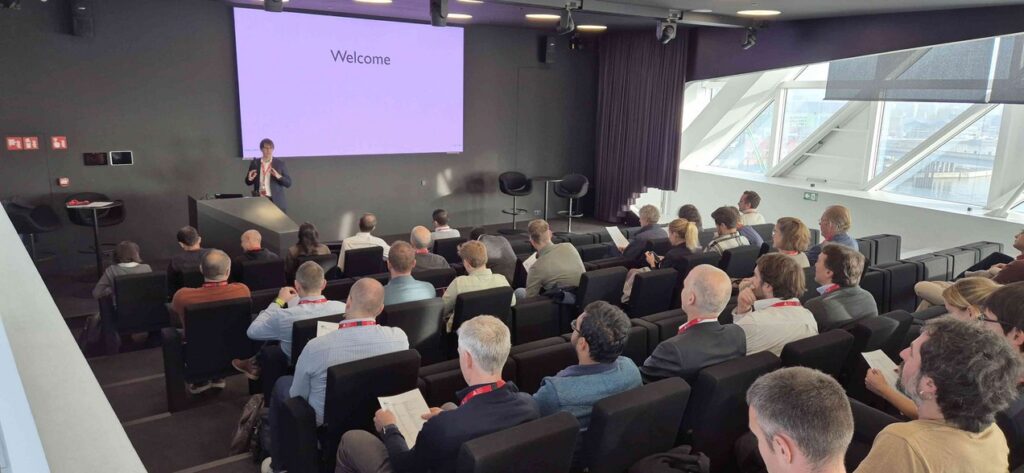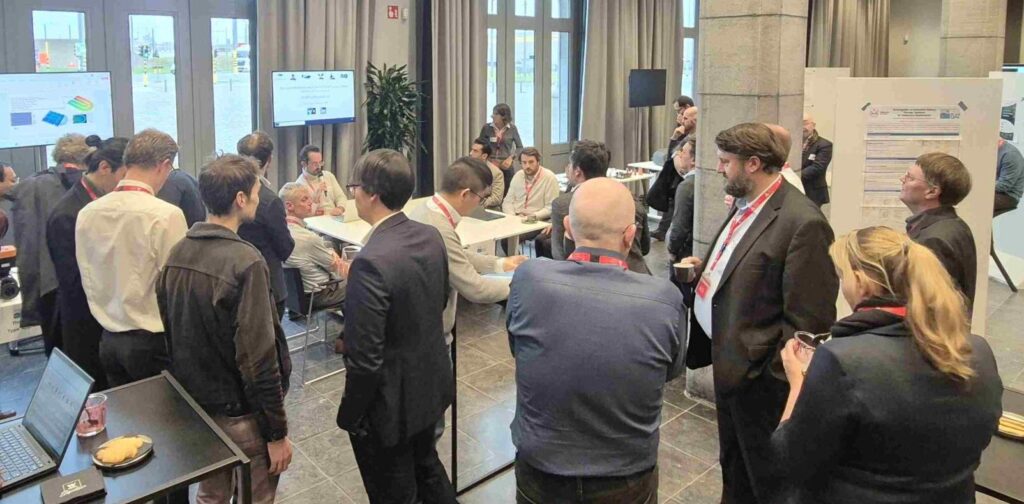On 13 November 2024, the SEABAT Final Event took place at the Port House in Antwerp, marking the culmination of four years of work on a fully electric marine battery concept. The SEABAT project (Solutions for largE bAtteries for waterBorne trAnsporT) aimed to address the urgent need to reduce maritime emissions, which is essential for meeting the International Maritime Organisation’s (IMO) goal of cutting greenhouse gas emissions from maritime transport by 50% by 2050.
While maritime electric propulsion shows significant potential, the technology remains in its early stages. Maritime applications have more stringent requirements compared to automotive, and integrated solutions for ships have yet to gain widespread adoption.
SEABAT tackled these challenges by developing a fully electric maritime hybrid concept that combines high-energy and high-power storage cells, aiming to reduce the cost of large waterborne transport battery systems. During the event, SEABAT shared its findings and discussed the future of maritime electrification, offering valuable insights into the complexities of this evolving technology. The agenda was as follows:
A Day of Innovation and Collaboration
The day was filled with insightful presentations, interactive demonstrations, and networking opportunities, designed to highlight the project’s advancements and offer a deeper understanding of the potential for electrification in shipping.
Opening: Vision, Welcome, and Structure
The event began with a brief introduction, setting the stage for the day’s proceedings. The organisers welcomed the attendees and provided an overview of SEABAT’s vision and goals, emphasising the importance of modular battery systems in reducing costs and promoting the adoption of electric ships across the industry. The opening session laid the foundation for the discussions that followed, focusing on the integration of sustainable technologies in the maritime sector.
You can find the presentation of the Project Introduction from this event here.
Session 1: Vision and Technology Foundations
The first presentation session featured a series of talks that set the broader context for the SEABAT project. The session began with a presentation on the European Commission’s (EC) view on electrification in ships, offering insights into EU policies aimed at supporting sustainable shipping technologies. Following this, the SEABAT team introduced the project’s goals and progress, highlighting its cost-optimal battery systems that will drive the transition to electric maritime transport. The session concluded with the “Ready for Boarding” initiative, which previewed SEABAT’s readiness for real-world implementation.
Session 2: The Heart of Innovation
The second presentation session delved deeper into the technical innovations that SEABAT is bringing to the maritime industry. Topics included integrated power electronics, which are crucial for optimising energy conversion in electric ships, and scalable software solutions that make it easier to manage and control these complex systems. The session concluded with an update on SEABAT’s prototype development, giving attendees a glimpse of the technology that is being brought to life.
Session 3: Demo Tour – A Hands-On Experience
The afternoon session began with an exciting Demo Tour, where attendees had the chance to visit various booths and see SEABAT’s innovations in action. The tour was organised into four groups, each visiting five different stations, including:
- Manufacturing and Assembly: Demonstrating the process of assembling SEABAT’s modular battery systems.
- Safety/Casing: Highlighting the safety features and casing solutions for battery storage and integration.
- Testing: Showcasing the rigorous testing protocols that ensure the reliability and efficiency of SEABAT’s systems.
- Architecture and Sizing Tool: Presenting the tools used to design and optimise the energy architecture for electric ships.
- Ship Integration: Exploring how SEABAT’s technologies integrate with existing ship designs to enable the adoption of electric propulsion.
The tour also included a Building Tour of the Havenhuis itself, allowing attendees to explore the stunning architecture of this iconic landmark.
Session 4: Expert Insights – Networking and Discussions
The “Meet the Experts” session allowed participants to network over coffee, providing an informal space for deeper conversations. Linked EU projects from the EUWT-SE collaboration were also presented during a round table discussion. The session also covered additional demos and topics such as thermal systems, control and communication, type approval, and scientific publications. These discussions offered valuable insights into the future of ship electrification and the broader challenges and opportunities in the sector.
Session 5: Road to Market
In the next session, the focus shifted to the road to market, exploring how SEABAT’s innovations can be successfully scaled and commercialised. The speaker discussed the steps needed to bring the modular electric systems to market, addressing barriers to adoption and the key role of industry collaboration in overcoming these challenges.
You can find the “Road to Market” from this event here.
Session 6: Panel Session – Exploring the Future
The event wrapped up with an engaging Panel Session, where a group of industry experts and stakeholders explored various aspects of electrification in the maritime sector. The session addressed key questions related to hybrid battery applications, the industrialisation of modular battery systems, and the integration of battery technology into new electrified ships. Experts discussed the benefits and challenges of retrofitting existing vessels versus designing new, fully electric ships. They also examined trends in decarbonisation, such as engine conversions to methanol and CO2 capturing for GHG reduction. The panel concluded with a focus on the evolving EMSA guidelines and the risks associated with the next steps in the development of modular battery systems for maritime use.
Closing Remarks
The final session offered a summary of the day’s highlights and reflections on the progress made throughout the SEABAT project. The team thanked all participants and emphasised the importance of continued collaboration in achieving the goal of making electric ships a common and economically viable solution in the maritime industry.
Conclusion: Paving the Way for a Sustainable Maritime Future
The SEABAT final event showcased the immense potential of modular, fully electric battery systems in revolutionising the maritime industry. By significantly reducing the costs of large waterborne battery systems, SEABAT is poised to play a crucial role in the transition to greener, more sustainable shipping. The event not only highlighted the technical advancements made by the project but also fostered valuable discussions on the path forward for the adoption of electric technologies in the maritime sector. With continued innovation and collaboration, the future of maritime electrification looks brighter than ever, and SEABAT has played a crucial role in this journey.






